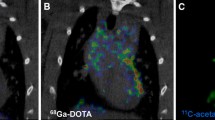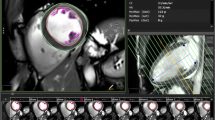Abstract
Purpose
To evaluate the reliability of quantitation of myocardial viability on cardiac F-18 fluorodeoxyglucose (FDG) positron emission tomography (PET) scans with three different methods of visual scoring system, autoquantitation using commercially available autoquantitation software, and infarct-size measurement using histogram-based maximum pixel threshold identification on polar-map in rat hearts.
Methods
A myocardial infarct (MI) model was made by left anterior descending artery (LAD) ligation in rat hearts. Eighteen MI rats underwent cardiac FDG-PET-computed tomography (CT) twice within a 4-week interval. Myocardium was partitioned into 20 segments for the comparison, and then we quantitated non-viable myocardium on cardiac FDG PET-CT with three different methods: method A—infarct-size measurement using histogram-based maximum pixel threshold identification on polar-map; method B—summed MI score (SMS) by a four-point visual scoring system; method C—metabolic non-viable values by commercially available autoquantitation software. Changes of non-viable myocardium on serial PET-CT scans with three different methods were calculated by the change of each parameter. Correlation and reproducibility were evaluated between the different methods.
Results
Infarct-size measurement, visual SMS, and non-viable values by autoquantitation software presented proportional relationship to each other. All the parameters of methods A, B, and C showed relatively good correlation between each other. Among them, infarct-size measurement (method A) and autoquantitation software (method C) showed the best correlation (r = 0.87, p < 0.001). When we evaluated the changes of non-viable myocardium on the serial FDG-PET-CT- however, autoquantitation program showed less correlation with the other methods. Visual assessment (method B) and those of infarct size (method A) showed the best correlation (r = 0.54, p = 0.02) for the assessment of interval changes.
Conclusions
Commercially available quantitation software could be applied to measure the myocardial viability on small animal cardiac FDG-PET-CT scan. This kind of quantitation showed good correlation with infarct size measurement by histogram-based maximum pixel threshold identification. However, this method showed the weak correlation when applied in the measuring the changes of non-viable myocardium on the serial scans, which means that the caution will be needed to evaluate the changes on the serial monitoring.








Similar content being viewed by others
References
Iskander S, Iskandrian AE. Prognostic utility of myocardial viability assessment. Am J Cardiol. 1999;83:696–702.
Baer FM, Theissen P, Schneider CA, Eerhard V, Udo S, Harald S, et al. Dobutamine magnetic resonance imaging predicts contractile recovery of chronically dysfunctional myocardium after successful revascularization. J Am Coll Cardiol. 1998;31:1040–8.
Gibbons RJ, Miller TD, Christian TF. Infarct size measured by single photon emission computed tomographic imaging with 99mTc-sestamibi: a measure of the efficacy of therapy in acute myocardial infarction. Circulation. 2000;101:101–8.
Abraham A, Nichol G, Williams KA. 18F-FDG PET imaging of myocardial viability in an experienced center with access to 18F-FDG and integration with clinical management teams: the Ottawa-FIVE substudy of the PARR 2 trial. J Nucl Med. 2010;51:567–74.
Marshall RC, Tillisch JH, Phelpls ME, Huang SC, Carson R, Henze E, et al. Identification and differentiation of resting myocardial ischemia and infarction in man with positron computed tomography, 18F-labeled fluorodeoxyglucose and N-13 ammonia. Circulation. 1983;67:766–88.
Tillisch J, Brunken R, Marshall R, Schwaiger M, Mandelkern M, Phelps ME, et al. Reversibility of cardiac wall-motion abnormalities predicted by positron emission tomography. N Engl J Med. 1986;314:884–8.
Schwaiger M, Brunken R, Grover-McKay M, Krivokapich J, Child J, Tillisch J, et al. Regional myocardial metabolism in patients with acute myocardial infarction assessed by positron emission tomography. J Am Coll Cardiol. 1986;8:800–8.
Brunken R, Tillisch J, Schwaiger M, Child J, Marshall R, Mandelkern M, et al. Regional perfusion, glucose metabolism, and wall motion in patients with chronic electrocardiographic Q-wave infarctions: evidence for persistence of viable tissue in some infarct regions by positron emission tomography. Circulation. 1986;73:951–63.
Juhani Knuuti M, Nuutila P, Ruotsalainen U, Teras M, Sarste M, Harkonen R, et al. Voipio-Pulkki. The value of quantitative analysis of glucose utilization in detection of myocardial viability by PET. J Nucl Med. 1993;34:2068–75.
Germano G, Paul BK, Daniel SB. An automatic approach to the analysis, quantitation and review of perfusion and function from myocardial perfusion SPECT images. Int J Cardiovasc Imaging. 1997;13:337–46.
Paeng JC, Lee DS, Cheon GJ, Kim KB, Yeo JS, Chung JK, et al. Consideration of perfusion reserve in viability assessment by myocardial Tl-201 rest-redistribution SPECT: a quantitative study with dual-isotope SPECT. J Nucl Cardiol. 2002;9:68–74.
Faber TL, Cooke CD, Folks RD, Vansant JP, Nichols KJ, DePuey EG, et al. Left ventricular function and perfusion from gated perfusion images: an integrated method. J Nucl Med. 1999;40:650–9.
Ezekiel A, Van Train K, Berman D, Silagan G, Maddahi J, Garcia EV. Automatic determination of quantitation parameters from Tc-Sestamibi myocardial tomograms. Computers in Cardiology 1991, Proceedings. NY: IEEE; p 237–240.
Van Train K, Garcia EV, Maddahi J, Areeda J, Cooke CD, Kiat H, et al. Multicenter trial validation for quantitative analysis of same-day rest-stress technetium-99m-sestamibi myocardial tomograms. J Nucl Med. 1994;35:609–18.
Germano G, Kiat H, Kavanagh PB, Moriel M, Mazzanti M, Su HT, et al. Automatic quantification of ejection fraction from gated myocardial perfusion SPECT. J Nucl Med. 1995;36:2138–47.
Paeng JC, Lee DS, Cheon GJ, Lee MM, Chung JK, Lee MC. Reproducibility of an automatic quantitation of regional myocardial wall motion and systolic thickening in gated 99mTc-sestamibi myocardial SPECT. J Nucl Med. 2001;42:695–700.
Lecomte R, Croteau E, Gauthier ME, Archambault M, Aliga A, Rousseau J, et al. Cardiac PET imaging of blood flow, metabolism, and function in normal and infarcted rats. IEEE Trans Nucl Sci. 2004;51:696–704.
Kudo T, Fukuchi K, Annala AJ, Chatziioannou AF, Allada V, Dahlbom M, et al. Noninvasive measurement of myocardial activity concentrations and perfusion defect sizes in rats with a new small-animal positron emission tomogrgaph. Circulation. 2002;106:118–23.
Wu HM, Sui G, Lee CC, Prins ML, Ladno W, Lin HD, et al. In vivo quantitation of glucose metabolism in mice using small-animal PET and a microfluidic device. J Nucl Med. 2007;48:837–45.
Fang YD, Raymond Jr FM. Spillover and partial-volume correction for image-derived input functions for small-animal 18F-FDG PET studies. J Nucl Med. 2008;49:606–14.
Thomas D, Bal H, Arkles J, Horowitz J, Araujo L, Acton PD, et al. Noninvasive assessment of myocardial viability in a small animal model: comparison of MRI, SPECT, and PET. Magn Reson Med. 2008;59:252–9.
Sherif HM, Saraste A, Weidl E, Weber AW, Higuchi T, Reder S, et al. Evaluation of a novel (18) F-labeled positron-emission tomography perfusion tracer for the assessment of myocardial infarct size in rats. Circ Cardiovasc Imaging. 2009;2:77–84.
Higuchi T, Nekolla SG, Jankaukas A, Weber AW, Huisman MC, Reder S, et al. Characterization of normal and infarcted rat myocardium using a combination of small-animal PET and clinical MRI. J Nucl Med. 2007;48:288–94.
Woo SK, Lee YJ, Lee W, Kim MH, Park JA, Kim JS, et al. Quantitative assessment technology of small animal myocardial infarction PET image using Gaussian mixture model. Korean J Med Phys. 2011;22(1):42–51.
Girish V, Vijayalakshmi A. Affordable image analysis using NIH image/Image J. Indian J Cancer. 2004;41:47.
Baer FM, Voth E, Deutsch HJ, et al. Predictive value of low dose dobutamine transesophageal echocardiography and fluorine-18 fluorodeoxyglucose positron emission tomography for recovery of regional left ventricular function after successful revascularization. J Am Coll Cardiol. 1996;28:60–9.
Kitsiou AN, Bacharach SL, Bartlett ML, et al. 13N-ammonia myocardial blood flow and uptake. Relation to functional outcome of asynergic regions after revascularization. J Am Coll Cardiol. 1999;33:678–86.
Bland J, Altman D. Statistical methods for assessing agreement between two methods of clinical measurement. Lancet. 1986;1:307–10.
Lin GS, Hines HH, Grant G, Taylor K, Ryals C. Automated quantification of myocardial ischemia and wall motion defects by use of cardiac spect polar mapping and 4-dimensional surface rendering. J Nucl Med Technol. 2006;34:3–17.
Garcia EV, DePuey EG, Depasquale EE. Quantitative planar and tomographic thallium-201 myocardial perfusion imaging. Cardiovasc Intervent Radiol. 1987;10:374–83.
Benoit T, Vivegnis D, Foulon J, Rigo P. Quantitative evaluation of myocardial single-photon emission tomographic imaging: application to the measurement of perfusion defect size and severity. Eur J Nucl Med. 1996;23:1603–12.
Declerck J, Feldmar J, Goris ML, Betting F. Automatic registration and alignment on a template of cardiac stress and rest reoriented SPECT images. IEEE Trans Med Imaging. 1997;16:727–37.
Goris ML, Holtz B, Thirion JP, Similon P. Factors affecting and computation of myocardial perfusion reference images. Nucl Med Commun. 1999;20:627–35.
Kim JS, Lee JS, Lee JJ, Lee BI, Park MH, Lee HJ, et al. Effects of attenuation and scatter corrections in cat brain PET images using microPET R4 scanner. Nucl Med Mol Imaging. 2006;40:40–7.
Lee DS, Cheon GJ, Ahn JY, Chung JK, Lee MC. Reproducibility of assessment of myocardial function using gated 99mTc-MIBI SPECT and quantitative software. Nucl Med Commun. 2000;21:1127–34.
Itti E, Klein G, Rosso J, Evangelista E, Monin JL, Gueret P, et al. Assessment of myocardial reperfusion after myocardial infarction using 3-dimentional quantification and template matching. J Nucl Med. 2004;45:1981–8.
Acknowledgments
This study was partly supported by Korea University Intramural Research Grants (2011-K1131781 and 2011-K1132941)
The authors have no conflicts of interests.
Author information
Authors and Affiliations
Corresponding authors
Rights and permissions
About this article
Cite this article
Pahk, K., Oh, S.Y., Jeong, E. et al. Is it Feasible to Use the Commercially Available Autoquantitation Software for the Evaluation of Myocardial Viability on Small-Animal Cardiac F-18 FDG PET Scan?. Nucl Med Mol Imaging 47, 104–114 (2013). https://doi.org/10.1007/s13139-013-0206-8
Received:
Revised:
Accepted:
Published:
Issue Date:
DOI: https://doi.org/10.1007/s13139-013-0206-8




